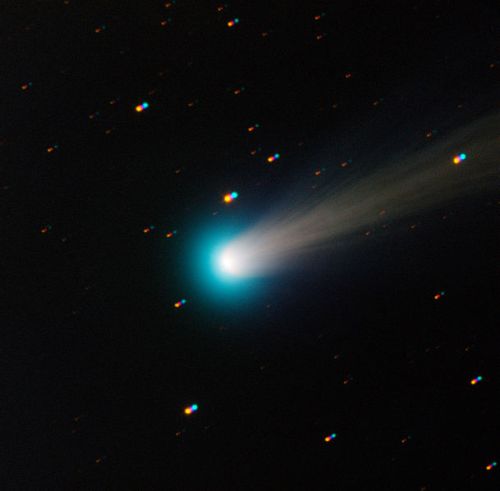
(Comet ISON – Photo Credit: TRAPPIST/E. Jehin/ESO)
A NASA-led team of scientists have created detailed 3-D maps of the atmospheres surrounding the ISON and Lemmon comets. This allowed them to identify several of the gases in their comas, revealing the presence of formaldehyde and HNC (hydrogen, nitrogen and carbon).
The team combined a high-resolution 2-D image of each comet’s gases alongside a detailed molecular spectrum. This allowed researchers to identify the molecules present and determine their velocities (speed plus direction). This information created the third dimension – the depth of the coma.
The 3-D perspective provided deep insights into which materials are shed from the nucleus of the comet and which are produced within the atmosphere (otherwise known as the coma). The 3-D maps also indicated whether each material was flowing outward evenly in all directions or coming off in jets or in clumps.
“We achieved truly first-of-a-kind mapping of important molecules that help us understand the nature of comets,” said Martin Cordiner, a researcher working in the Goddard Center for Astrobiology at NASA’s Goddard Space Flight Centre.
The study was conducted in 2013 on the Lemmon and ISON comets through the ALMA network of high-precision antennas in Chile. The network of 66 radio telescopes in Chile was completed last year and is the largest telescope of its type in the world.
 (ISON’s trajectory through the solar system – Photo Credit: B. Saxton (NRAO/AUI/NSF); NASA/ESA Hubble; M. Cordiner, NASA, et al)
(ISON’s trajectory through the solar system – Photo Credit: B. Saxton (NRAO/AUI/NSF); NASA/ESA Hubble; M. Cordiner, NASA, et al)
In each comet, the team found that two materials – formaldehyde and HNC (made of one hydrogen, one nitrogen and one carbon) – were produced in the comet’s coma.
Researchers already suspected that formaldehyde would be present but the new maps contained enough detail to identify that the clumps of material were moving into different regions of the coma day-by-day and even hour-by-hour.
The investigations also settled a long-standing question about HNC’s source.
Scientists used to think that HNC was an interstellar material that originated from the nucleus of a comet, however this study provided the first proof that HNC is produced when larger molecules, or organic dust, break down in the coma.
“Understanding organic dust is important, because such materials are more resistant to destruction during atmospheric entry, and some could have been delivered intact to early Earth, thereby fueling the emergence of life,” said Michael Mumma, Director of the Goddard Center for Astrobiology, and a co-author on the study. “These observations open a new window on this poorly known component of cometary organics.”